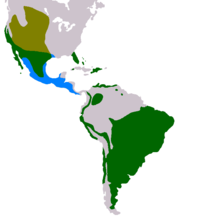貓頭鷹 来自维基百科,自由的百科全书
穴小鴞(學名:Athene cunicularia),鴟鴞科小鴞屬(Athene)的一種,因住在洞穴而得名。主要分布於北美洲及南美洲地區。常見於草原、牧地、農業地區、荒漠,或者低植被的乾燥區域[1]。有別於其他種貓頭鷹僅活動於夜間,穴小鴞於日間依舊能照常活動,亦因此,其狩獵時間自黃昏即已開始。
| 穴小鴞 | |
|---|---|

| |
| 成年的佛羅里達穴鴞(A. c. floridana) | |
| 科學分類 | |
| 界: | 動物界 Animalia |
| 門: | 脊索動物門 Chordata |
| 綱: | 鳥綱 Aves |
| 目: | 鴞形目 Strigiformes |
| 科: | 鴟鴞科 Strigidae |
| 屬: | 小鴞屬 Athene |
| 種: | 穴小鴞 A. cunicularia
|
| 二名法 | |
| Athene cunicularia (Molina, 1782)
| |
| 亞種 | |
|
約20種,詳見內文 | |

| |
| 綠色區塊為全球分布範圍 | |
| 異名 | |
|
Strix cunicularia Molina, 1782 | |
眼睛為亮黃色;額嘴依種類不同,為暗黃或灰色。成年後的穴鴞,頭部羽毛毛色轉為棕色,並在翅膀上有著白色的斑點。前胸、腹部的羽毛為白色,並因種類不同,而有著棕色的斑點或條紋。比起其他貓頭鷹來說,穴鴞飛行的能力雖然較為不佳,但其細長的腳卻有利於捕捉草叢或水邊的獵物。
雄性穴鴞與雌性穴鴞在外貌上相差無幾,雌性相對於雄性較為碩大,而雄性之翅翼與尾巴則較雌性來的修長。成年雄性穴鴞,因較常在洞外活動,羽毛因被太陽曝曬而變色,相比於雌性穴鴞來的明亮。成年穴鴞僅大於美洲知更鳥(American Robin)些許,身長約25公分,體重約170公克[1]。
於骨學(osteology)和脫氧核糖核酸序列數據中顯示,穴鴞為小鴞屬中的陸生動物(Terrestrial animal)變體。在分類方面形成了為數不少的亞種,但是牠們在外觀上相異不多,並且尚有幾個需進一步研究,方能證實[2]。
多數亞種被發現於安地斯山脈附近與安的列斯群島上,唯獨北方穴鴞(或稱西方穴鴞)與佛羅里達穴鴞(Florida Burrowing Owl)被發現於美國。以下為穴鴞下屬的亞種列表[3]:
在歐洲殖民美洲之前,穴鴞廣泛的分布於新大陸各個適於其生存之地。但是在歐洲列國的殖民下,生態遭到破壞,於北美洲僅於限定區域生存,如北美大平原、佛羅里達等地區。而在南美洲,其生存範圍,亦隨著森林開伐而不斷減少。
大多數的穴鴞不具遷徙之習性,一年四季皆在其生存地區活動。他們的壽命大約9到10年[4]。天敵包括獾、土狼、蛇和人類(於飛行途中遭行經車輛給撞死)。
在狩獵時,牠們會在棲息處靜靜觀察著,直到獵物出現,再從至高點像獵物猛撲,並抓往空中,使之無法逃離。其獵物組成為無脊椎動物與小型的脊椎動物,分別在其飲食比例上占了三分之一和三分之二的比例。大部分來說,穴鴞通常以大型昆蟲與小型的嚙齒目動物,而像地松鼠此類動物,穴鴞雖然時常接近,但捕食機率不高。
再有鱗目和兩棲動物中,穴鴞尤其偏好蜥虎、青蛙和蟾蜍。通常情況下,穴鴞所獵捕之脊椎動物為脫離群體,落單的個體[5]。而穴鴞最常獵捕的脊椎動物是小型鳥類,如:哀鴿屬[6]。
而在無脊椎動物方面,穴鴞並沒特別的偏好與特定獵食對象。舉凡白蟻、直翅目的螽斯科與沙螽科(Jerusalem cricket)、蟋蟀、金龜子、狼蛛、蠍子、馬陸、步行蟲(Ground beetle)皆為其狩獵之對象[6]。
不同於其他貓頭鷹,穴鴞為雜食動物,除了昆蟲、小型脊椎動物外,亦吃果子、種子,尤其是仙人掌的果實。在克拉里翁島,因缺乏可獵食之小型哺乳動物,穴鴞以蟋蟀、仙人掌果實為哺育幼兒的主食,哀鴿等小型鳥類則為輔[7]。

穴鴞的繁殖季節為3月下旬或4月開始,為一夫一妻制,但亦偶有雄性穴鴞有著兩個甚至以上之配偶的情形發生,但僅為少數[1]。他們通常於平原或大草原築建繁殖的棲所,但視情形而定,亦有發生過穴鴞於機場、高爾夫球場、農地等開闊性場地築建棲所的案例發生。
在繁殖季節時,穴鴞會到處收集各式各樣的材料來築建牠們的巢。最常見的材料為糞便,並以牛糞居多。早些時候,使用糞便裝飾此一舉動多半被認為是掩蓋氣味,使天敵未能發現他們之巢穴。然實驗顯示,此舉並未任何幫助於此,並進而發現,此一功能類似於捕鼠器,吸引獵物前來,進而方便於自家門前狩獵,便於哺育幼兒[8]。
生產期大概1至2天,直至一窩蛋全部產完,每次生產會產下4-12顆蛋(通常為9顆)。生產完接下來是3-4個星期的孵化期,此一時間由雄性穴鴞負責在外狩獵。小穴鴞誕生後須歷經4個星期方能進行短程飛行與離開巢穴,此段時間則由父母輪流照顧、餵養。通常到最後能安然離開巢穴的僅4-5隻。

在IUCN的評鑑下歸屬為無危物種[9],然而在加拿大,穴鴞屬瀕危物種[10]。在科羅拉多其數量亦不斷減少中。牠們普遍分布在新熱帶界國家的開放區域中,在城市裡,像是公園、停車場等地都可見到其身影與居住過的痕跡。而生存於附近亞馬遜雨林的穴鴞因為森林被人類不斷的砍伐下,棲息地與以往相比,逐漸縮小。在美國、加拿大、墨西哥地區,瀕臨絕種野生動植物國際貿易公約附錄二中的制約所保護著。
在北美洲,對於草原犬鼠的控管,致使穴鴞棲所因而減少。於此,穴鴞開始遷往城市,與人類共生,造成上述於高爾夫球場、機場等開闊地區發現其巢穴的狀況發生,也因此造成人為過失致死的情況也提升,數量旋即減少[11][12]。
為佛羅里達大西洋大學(Florida Atlantic University)下屬之球隊佛羅里達大西洋貓頭鷹隊(Florida Atlantic Owls)的吉祥物[13]。
Seamless Wikipedia browsing. On steroids.